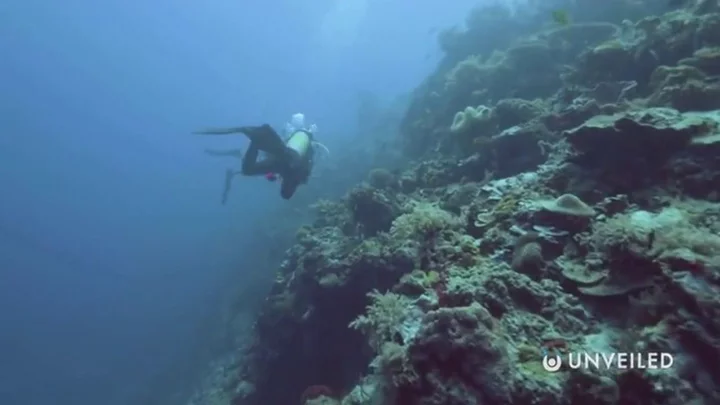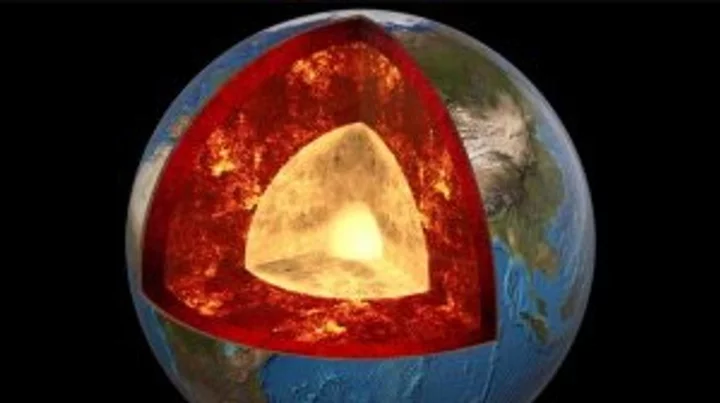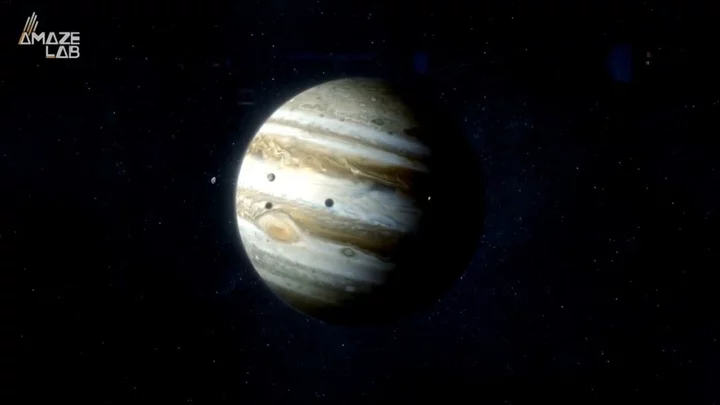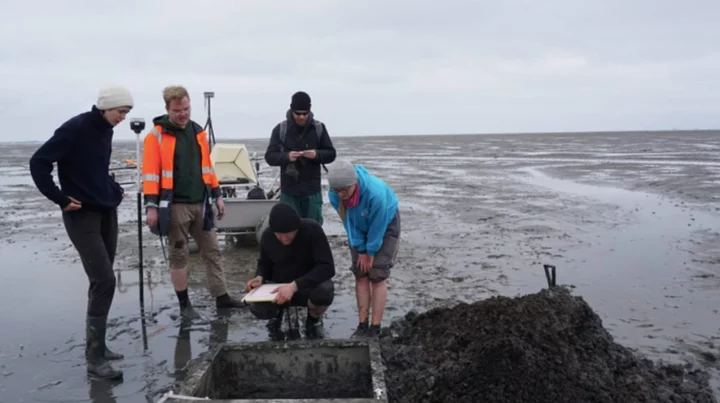
Every glass of water you have drank contains dinosaur wee
Experts have explained the reason why every glass of water we consume has dinosaur urine in it and it's not as gross as it sounds. When you get a cold glass of water from the tap, chances are you don’t think much about it before getting it down the hatch, so long as it looks clean. But, water experts have explained that the water you’re drinking may have gone through a dinosaur or even through your neighbour, before getting to you. This is because every drop of water on Earth has gone through a continuous water cycle over billions of years, and the amount of water on the planet at any given time is always the same. Severn Trent Water explained more, telling the Birmingham Mail how our planet's water cycle works. Sign up to our free Indy100 weekly newsletter They explained: “ Heat energy from the sun causes water to evaporate into the atmosphere from sea, lakes and the soil. “Air currents containing water vapour rise over higher ground into cooler temperatures which causes condensation and creates clouds. “More air currents cause the clouds to move around the Earth, across sea and land. As the clouds cool, precipitation as snow, sleet, hail or rain.” They explained that the vast majority of precipitation on Earth ends up back in waterways, such as seas, lakes and rivers. Continuing, they revealed: “97 per cent of the world’s water is salty sea water, two per cent is frozen in the polar ice caps and one per cent is fresh water for us to use.” Water companies collect and store water in reservoirs, which is then treated and tested by the Environment Agency and Drinking Water Inspectorate. It can then be distributed to homes through pipes. Then, the wastewater that has been used is transported through drains and sewers to sewage treatment works and returned to streams and rivers. Have your say in our news democracy. Click the upvote icon at the top of the page to help raise this article through the indy100 rankings.
2023-06-15 23:53

Nasa astronaut claims that aliens have prevented a nuclear war on Earth
Could we have aliens to thank for preventing a nuclear war on Earth? That’s what one former Nasa astronaut has claimed. Edgar Mitchell, who was involved in the Apollo 14 mission, gained a reputation for sharing conspiracy theories when he arrived back from the moon in 1971. Mitchell was the sixth man on the moon and was the Lunar Module Pilot on Apollo 14. Before his death in 2016, Mitchell spoke at length claiming that aliens visited Earth. Speaking to the Mirror, he alleged that aliens were responsible for preventing nuclear war between the US and the Soviets at the height of Cold War tensions. Sign up to our free Indy100 weekly newsletter At the time, Mitchell focused on the White Sands Missile Range facility in New Mexico. “White Sands was a testing ground for atomic weapons – and that's what the extraterrestrials were interested in,” he said. "They wanted to know about our military capabilities. My own experience talking to people has made it clear the ETs had been attempting to keep us from going to war and help create peace on Earth." White Sands Missile Range is where the first atomic bomb was tested in 1945, and Mitchell claimed that officers there had told him aliens had shot down missiles flying over the site. The claims were, as you’d expect, disputed. UFO expert Nigel Watson told IFL Science at the time: "To me, this is just another case of UFO fantasy and speculation. When you try getting to the facts it is like trying to herd cats." Meanwhile, a UFO conspiracy theorist recently described the south pole as an “air traffic control” hub for aliens. A recent discussion centred on the Amundsen–Scott South Pole, which Eric Hecker claimed communicated with “exotic” crafts by sending neutrino rays up into space. Hecker went further by talking about “digital optical modules” buried a mile beneath the surface under the ice. He claims they were buried in order to detect neutrino interactions while being deep enough not to interfere with radiation readings. Have your say in our news democracy. Click the upvote icon at the top of the page to help raise this article through the indy100 rankings.
2023-06-15 23:21

Two giant 'blobs' in Earth's core could be remains of an ancient planet
Many of us look to the stars for answers to life’s most complex questions. But actually, some of the greatest mysteries lie beneath our very feet. One might think we’d know the Earth pretty well by now but, in fact, our planet’s core remains shrouded in enigma. Indeed, there are two gigantic blobs located beneath Africa and the Pacific Ocean that occupy around six per cent of the world’s entire volume. And yet, we’re still not entirely sure what they’re made of or where they came from. There are a number of hypotheses, including that they are piles of oceanic crust that have accumulated over billions of years. Sign up for our free Indy100 weekly newsletter But a more interesting theory is that they are huge chunks of an ancient planet that hit the Earth around 4.5 billion years ago. To give an indication of just how massive these things are, the structure under Africa – an area known as Tuzo – is thought to be around 800km (497 miles) tall – the equivalent of some 90 Mount Everests stacked on top of one another, as IFLScience notes. The problem with determining the origin of these monster formations is that there are no direct ways of observing the Earth’s core. The deepest hole humans have ever dug – branded the "entrance to hell" – reached a pretty staggering 12,263m (40,230ft), but that doesn’t even come close to breaking through the crust to the layers beneath. Our most effective tool for analysing what lies beneath the ground is a technique called seismic tomography, which looks at how waves of energy travel when earthquakes occur. Since rocks and liquids have different densities, the waves move through them at different speeds. By measuring the tremors from different points on the surface, geologists can determine what kind of material the waves are travelling through and, in so doing, map out the Earth’s interior. It was by using this technique that the two unusual structures – known as large low shear velocity provinces (LLSVPs) – were found. Waves travel more slowly in these areas – fondly known as “blobs” – than through the surrounding lower mantle, indicating that they’re made of something different. We can’t tell what this material is based on seismic tomography data alone, but some scientists like to believe that they are the remnants of an ancient planet called Theia – an idea known as the “giant impact hypothesis”. According to this hypothesis, around 4.5 billion years ago, a Mars-sized object collided with the Earth. This impact not only created the planet we call home today, but also threw off enough rock to form the moon that lights up our night skies. Some scientists suggest that some of Theia’s leftovers also sunk to the bottom of the planet, probably settling somewhere above the core – thereby forming at least one of the two LLSVPs. More Updates About Strange Blob Structures Inside Planet Earth youtu.be Experts have been investigating the area for decades but there’s still no way of knowing for sure just what these two giant blobs are. Still, studies into Theia have offered important insights into how the possible collision might have kickstarted key plate tectonic and mantle motion inside our planet – crucial processes for establishing the world on which we live. It’s also a useful reminder that we still have so much to learn about our planet and where we came from. Have your say in our news democracy. Click the upvote icon at the top of the page to help raise this article through the indy100 rankings.
2023-06-14 15:17

Animation goes viral for showing 'what happiness really looks like'
Happiness is one of life’s most elusive gifts – it is an emotion that can’t be pinned down. And yet, an animation showing a protein molecule “walking along”, carrying a large sphere, is widely credited with being a visual representation of joy itself. The gif has trended online for almost a decade but continues to breed delight in those who see it. Many people believe that it is – to use the technical terms – a myosin transporting endorphins in the brain. In other words, it is a scientific portrayal of the actual processes that give us that warm and fuzzy feeling. Sign up for our free Indy100 weekly newsletter However, though we’d hate to dampen the mood, this isn’t quite accurate. In fact, the real brain behind the original clip, medical artist John Liebler, set out the truth back in 2014. @mommyca713 AMAZING! #cells #innerlife #happiness #lookslike #facts #fact #fyi #fyp #brain #research #facts #animation #myosin #interesting #education #viral #fypシ #humanbrain #mentalhealth #science #stem He explained that he, his team at medical technology company XVIVO, and two Harvard University researchers created the 3D computer animation in 2006 for a biology classroom video called ‘The Inner Life of the Cell’, as Science Alert reports. The educational clip wasn't intended to depict a brain process at all but to take the viewer "on a journey through the microscopic world of a cell, illustrating mechanisms that allow a white blood cell to sense its surroundings and respond to an external stimulus,” according to Liebler himself. So this is all about a protein in a white blood cell, not a protein in a neuron. The Inner Life of the Cell Animation youtu.be At any rate, happiness doesn’t just come about through a single process. So even if the clip did show endorphins being delivered to our brains, this wouldn’t offer a full picture. Dopamine, other neurotransmitters (for example, serotonin), biological health and genetics all play a part in cementing our feelings of contentment. We don’t just rely on jolly little myosin proteins lugging around bundles of cheer. Still, the internet is now awash with jovial variations on the clip and it can’t be denied that the scene-stealing strutting protein is pretty damn cute. So if that’s enough to bring a smile to your face, maybe it is a representation of happiness after all. Have your say in our news democracy. Click the upvote icon at the top of the page to help raise this article through the indy100 rankings.
2023-06-13 18:19

Astronomers have finally figured out the source of the brightest explosion ever recorded
Astronomers believe they might have found the source of the brightest explosion ever in space. The record-breaking explosion recorded in October 2022 was the most powerful ever seen, leaving equipment and instruments struggling to measure it as it pointed directly at planet Earth. The bright gamma-ray burst is officially called GRB 221009A and when it first went off, scientists were left scrabbling to point telescopes in its direction to record it. The explosion has affectionately been nicknamed BOAT, standing for “brightest of all time”, and was caused by the death of a large star located 2.4 billion light-years away – relatively close in terms of space activity. The star collapsed into a black hole after ejecting its outer envelope, causing this huge, bright explosion comprised of gamma rays, producing not only a narrow structured jet but with an additional outflow of gas. Sign up to our free Indy100 weekly newsletter This “exceptionally rare event” surprised astronomers, who had not predicted the existence of gas, and certainly provides plenty of new information around the question of how black holes form. The study’s lead author and astronomer from George Washington University, Brendan O'Connor, explained: “GRB 221009A represents a massive step forward in our understanding of gamma-ray bursts, and demonstrates that the most extreme explosions do not obey the standard physics assumed for garden variety gamma-ray bursts.” He continued: “GRB 221009A might be the equivalent Rosetta stone of long GRBs, forcing us to revise our standard theories of how relativistic outflows are formed in collapsing massive stars.” The huge and long-lasting blast measured up to 18 teraelectronvolts which is a staggering record for a gamma-ray burst, leaving scientists to hypothesise that it was a supernova. Have your say in our news democracy. Click the upvote icon at the top of the page to help raise this article through the indy100 rankings.
2023-06-12 22:26

Massive ocean discovered beneath the Earth's crust containing more water than on the surface
It feels like there have been staggering science stories emerging every other day recently, all of which have blown our tiny little minds. First, there was the discovery of a terrifying black hole pointing right at us, then there was a huge hole found in the sun and a missing continent found after going missing for 375 years. Now, people are only just realising that there’s a massive ocean hidden under the Earth’s crust. It turns out there’s a huge supply of water 400 miles underground stored in rock known as 'ringwoodite'. Sign up to our new free Indy100 weekly newsletter Scientists previously discovered that water is stored inside mantle rock in a sponge-like state, which isn’t a liquid, solid or a gas, but instead a fourth state. The scientific paper titled ‘Dehydration melting at the top of the lower mantle’ was published in 2014 and laid out the findings. "The ringwoodite is like a sponge, soaking up water, there is something very special about the crystal structure of ringwoodite that allows it to attract hydrogen and trap water," said geophysicist Steve Jacobsen at the time. "This mineral can contain a lot of water under conditions of the deep mantle,” added Jacobsen, who was part of the team behind the discovery. He added: "I think we are finally seeing evidence for a whole-Earth water cycle, which may help explain the vast amount of liquid water on the surface of our habitable planet. Scientists have been looking for this missing deep water for decades." Scientists made the findings at the time after studying earthquakes and discovering that seismometers were picking up shockwaves under the surface of the Earth. From that, they were able to establish that the water was being held in the rock known as ringwoodite. If the rock contained just 1 per cent water, it would mean that there is three times more water under the surface of the Earth than there is in the oceans on the surface. Have your say in our news democracy. Click the upvote icon at the top of the page to help raise this article through the indy100 rankings.
2023-06-12 15:28

Ancient formation discovered wrapped around Earth's core
The structure of the Earth beneath our feet has been fascinating to members of the scientific community recently, and it turns out it’s far more complex than people initially thought. First, we learned of the news that there’s a massive ocean beneath the Earth’s crust which contains more water than all of the seas on the surface. Now, another study has been published which has taken an in-depth look at the geology beneath the southern hemisphere. The new research, published in Science Advances, has found evidence that an entire ocean floor actually runs the length around the core. Sign up to our new free Indy100 weekly newsletter This is a relatively thin layer that sits on the core-mantle boundary around 1,800 miles beneath the surface of the Earth. It's an ancient formation that could provide more insight into the structure of the planet beneath our feet. Geologist Samantha Hansen and her colleagues from the University of Alabama led the research. They observed the structure by using 15 monitoring stations under the ice of Antarctica, mapping the waves from earthquakes. Doing this allowed them to analyse the structure of the Earth below the surface, including the ultra-low velocity zones where waves moved much slower. "Seismic investigations, such as ours, provide the highest resolution imaging of the interior structure of our planet, and we are finding that this structure is vastly more complicated than once thought," Hansen said. "Analyzing [thousands] of seismic recordings from Antarctica, our high-definition imaging method found thin anomalous zones of material at the CMB everywhere we probed," geophysicist Edward Garnero from Arizona State University also said. "The material's thickness varies from a few kilometers to [tens] of kilometers. This suggests we are seeing mountains on the core, in some places up to five times taller than Mt. Everest." "Our research provides important connections between shallow and deep Earth structure and the overall processes driving our planet," Hansen added. Have your say in our news democracy. Click the upvote icon at the top of the page to help raise this article through the indy100 rankings.
2023-06-12 15:21

Scientists baffled by discovery of '2000-year-old computer'
Scientists have been left baffled by the discovery of the wreck of a 2,000-year-old “computer” that is amazingly complex. The Antikythera mechanism – an astronomical calendar – has been dubbed “‘the first computer” and has baffled scientists for generations after it was first discovered inside a Greek shipwreck in 1901. The device is a hand-powered time-keeping instrument that used a wing-up system to track the sun, moon and planets’ celestial time. It also worked as a calendar, tracking the phases of the Moon and the timing of eclipses. Despite sounding relatively simple, the mechanism was actually ahead of its time, being more technically sophisticated than any other tool that was invented over the next 1,000 years. In its current condition, the mechanism is in 82 separate fragments with only a third of its original structure remaining, including 30 corroded bronze gearwheels. Sign up to our free Indy100 weekly newsletter Research into the device from experts at University College London involved 3D computer modelling and helped them solve the mystery of how the device worked, revealing a “creation of genius”. Adam Wojcik, a materials scientist at UCL said at the time: “We believe that our reconstruction fits all the evidence that scientists have gleaned from the extant remains to date.” They theorised that the device tracked the movement of the sun, moon and planets on concentric rings, as the ancient Greeks believed that the sun and planets revolved around Earth, rather than the sun. The researchers explained in Scientific Reports: “Solving this complex 3D puzzle reveals a creation of genius—combining cycles from Babylonian astronomy, mathematics from Plato’s Academy and ancient Greek astronomical theories.” Have your say in our news democracy. Click the upvote icon at the top of the page to help raise this article through the indy100 rankings.
2023-06-02 19:16

Scientists make 'shocking' discovery on Saturn's moon that could reveal signs of life
Dramatic explosions on the surface of one of Saturn's moons have been observed, and it could change the way scientists approach the search for life in the universe. Saturn's ice-covered moon Enceladus has been the subject of attention from astronomers for decades after plumes of water vapor were observed erupting from its surface 20 years ago by the Cassini spacecraft. Now, the biggest plume yet has been spotted by the James Webb Space Telescope and it measures a massive 10,000 kilometers in length. Incredibly, the plume emitting from the geyser on the surface measures 20 times the size of the moon itself, and it indicates that there’s more to Enceladus than previously thought. Sign up to our free Indy100 weekly newsletter Planetary scientist Geronimo Villanueva of NASA's Goddard Space Flight Center said: "When I was looking at the data, at first, I was thinking I had to be wrong, it was just so shocking to map a plume more than 20 times the diameter of the moon. "The plume extends far beyond what we could have imagined." Instead of solid ice, the size of the plume shows us that there’s a liquid ocean under the surface. It’s kept warm enough to avoid freezing due to the movement that results from the gravitational pull of Saturn. As ever, the existence of liquid water suggests that there’s the possibility of life existing there, and it's encouraging news for authors of the study accepted in Nature Astronomy. "The orbit of Enceladus around Saturn is relatively quick, just 33 hours. As it whips around Saturn, the moon and its jets are basically spitting off water, leaving a halo, almost like a donut, in its wake," Villanueva said. "In the Webb observations, not only was the plume huge, but there was just water absolutely everywhere." It remains one of the most interesting bodies being studied in the solar system, as geochemist Christopher Glein of the Southwest Research Institute. “Enceladus is one of the most dynamic objects in the Solar System and is a prime target in humanity's search for life beyond Earth," geochemist Christopher Glein of the Southwest Research Institute said. "In the years since NASA's Cassini spacecraft first looked at Enceladus, we never cease to be amazed by what we find is happening on this extraordinary moon." Have your say in our news democracy. Click the upvote icon at the top of the page to help raise this article through the indy100 rankings.
2023-06-01 22:26

A 'City of Atlantis' has been discovered after being lost for 600 years
The remains of a church from a sunken town known as the 'Atlantis of the North Sea' has been discovered beneath the mud on Germany's coast. The church is believed to be part of a site called 'Rungholt' located in the Wadden Sea. The town, which was previously thought to be a local legend, has not been seen since 1362 after it was submerged beneath the waves during an intense storm. However, new research has shown that the town really did exist and that they had built reinforcements around the settlement to protect them from the severe elements. The research was carried out on the area by archeologists from Kiel University, Johannes Gutenberg University Mainz, the Center for Baltic and Scandinavian Archaeology, and the State Archaeology Department Schleswig-Holstein. Sign up to our free Indy100 weekly newsletter Searching the Wadden Sea which is the longest stretch of intertidal sand and mud flats on Earth, the team, using geophysical imaging technology found man-made mounds that had been constructed to protect the town against the tides. Amongst this structure were the foundations of a building which the team determined had to be a church which may have been the location of the town centre. In a statement, Dr. Dennis Wilken, a geophysicist at Kiel University of Kiel University said: "Settlement remains hidden under the mudflats are first localized and mapped over a wide area using various geophysical methods such as magnetic gradiometry, electromagnetic induction, and seismics." Dr. Hanna Hadler from the Institute of Geography at Mainz University added: "Based on this prospection, we selectively take sediment cores that not only allow us to make statements about spatial and temporal relationships of settlement structures, but also about landscape development." Dr. Ruth Blankenfeldt, an archaeologist at ZBSA also suggested that the "special feature of the find lies in the significance of the church as the centre of a settlement structure, which in its size must be interpreted as a parish with superordinate function." The storm that washed away Rungholt has gone down in history as one of the largest to ever hit the region, affecting not just Germany but also the Netherlands, Denmark and the UK. The storm happened on January 1362 and has since been referred to as "the great drowning of men." According to historical reports, Rungholt was once a busy trading port for fishermen but was also populated by taverns, brothels and churches. Have your say in our news democracy. Click the upvote icon at the top of the page to help raise this article through the indy100 rankings.
2023-05-31 17:21

Europe's 'City of Atlantis' discovered after being lost for 600 years
The remains of a church from a sunken town known as the 'Atlantis of the North Sea' has been discovered beneath the mud on Germany's coast. The church is believed to be part of a site called 'Rungholt' located in the Wadden Sea. The town, which was previously thought to be a local legend, has not been seen since 1362 after it was submerged beneath the waves during an intense storm. However, new research has shown that the town really did exist and that they had built reinforcements around the settlement to protect them from the severe elements. The research was carried out on the area by archeologists from Kiel University, Johannes Gutenberg University Mainz, the Center for Baltic and Scandinavian Archaeology, and the State Archaeology Department Schleswig-Holstein. Sign up to our free Indy100 weekly newsletter Searching the Wadden Sea which is the longest stretch of intertidal sand and mud flats on Earth, the team, using geophysical imaging technology found man-made mounds that had been constructed to protect the town against the tides. Amongst this structure were the foundations of a building which the team determined had to be a church which may have been the location of the town centre. In a statement, Dr. Dennis Wilken, a geophysicist at Kiel University of Kiel University said: "Settlement remains hidden under the mudflats are first localized and mapped over a wide area using various geophysical methods such as magnetic gradiometry, electromagnetic induction, and seismics." Dr. Hanna Hadler from the Institute of Geography at Mainz University added: "Based on this prospection, we selectively take sediment cores that not only allow us to make statements about spatial and temporal relationships of settlement structures, but also about landscape development." Dr. Ruth Blankenfeldt, an archaeologist at ZBSA also suggested that the "special feature of the find lies in the significance of the church as the centre of a settlement structure, which in its size must be interpreted as a parish with superordinate function." The storm that washed away Rungholt has gone down in history as one of the largest to ever hit the region, affecting not just Germany but also the Netherlands, Denmark and the UK. The storm happened on January 1362 and has since been referred to as "the great drowning of men." According to historical reports, Rungholt was once a busy trading port for fishermen but was also populated by taverns, brothels and churches. Have your say in our news democracy. Click the upvote icon at the top of the page to help raise this article through the indy100 rankings.
2023-05-28 19:27

Scientists might have discovered a simple way to stop the ageing process
The feeling of hunger could be a simple way to stop the ageing process, according to a new study. Researchers at the University of Michigan tricked fruit flies into feeling hungry which resulted in the insects living longer – even when they eat their calorie intake. The study - published in Science - suggests that the perception of insatiable hunger alone can generate the anti-aging effects of intermittent fasting. (And since it’s the perception rather than actual hunger, it means the bugs don’t actually have to starve). Sign up to our free Indy100 weekly newsletter "We've sort of divorced [the life extending effects of diet restriction] from all of the nutritional manipulations of the diet that researchers had worked on for many years to say they're not required," physiologist Scott Pletcher said, as per Michigan Medicine. "The perception of not enough food is sufficient." You may have heard the term intermittent fasting before, as it is a popular diet fad that consists of going for extended periods of time without eating, followed by a period of eating normally, according to Bupa. Despite its popularity, evidence supporting its benefits is limited in terms of research on humans. Perhaps you’re thinking… why fruit flies? Well, the insects actually share 75 percent of the same disease-related genes as us, while also sharing similar qualities to mammals in terms of their metabolisms and brains, according to Science Alert. In the research, branched-chain amino acids (BCAA) essential nutrients that appear to trigger feelings of fullness in flies when consumed, were used. The fruit flies maintained their hunger through getting fed snacks low in BCAA and their hunger was noticed through how much the insects ate from a buffet of food hours after eating the snack. More food was consumed by flies who earlier ate a low-BCAA snack, and they choose protein over carbs, focusing on what their hungry bodies needed. From learning this, the team directly activated the neurons in fruit flies that trigger hunger responses, they found these hunger-stimulated flies also lived longer. "Demonstration of the sufficiency of hunger to extend life span reveals that motivational states alone can be deterministic drivers of ageing," Pletcher and colleagues wrote in the findings. Along with fruit flies, rodents have also been part of the study and both seems to suggest calorie restriction can extend life and is good for our health too. Though of course, more extensive research is required to see whether or not this is also the case with humans. Have your say in our news democracy. Click the upvote icon at the top of the page to help raise this article through the indy100 rankings.
2023-05-28 01:27
